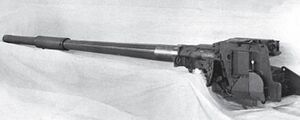115/51 64M: Difference between revisions
No edit summary |
No edit summary |
||
| (3 intermediate revisions by the same user not shown) | |||
| Line 102: | Line 102: | ||
====MDS-115/1 Sahm Hamra==== | ====MDS-115/1 Sahm Hamra==== | ||
* '''Total round mass''': 22.0 kg | * '''Total round mass''': 22.0 kg | ||
* '''Projectile mass (with sabot)''': 3.196 kg (5. | * '''Projectile mass (with sabot)''': 3.196 kg (5.55 kg) | ||
* '''Muzzle velocity''': 1, | * '''Penetrator length''': 436 mm | ||
* '''Penetrator average diameter''': 34 mm | |||
* '''Penetrator L/D ratio''': ~13:1 | |||
* '''Muzzle velocity''': 1,686.5 m/s | |||
* '''Velocity loss per 1 km''': 128.5 m/s | * '''Velocity loss per 1 km''': 128.5 m/s | ||
* '''Penetration at 1 km''': 270 mm at 0°/155 mm at 60° | |||
* '''Penetration at 2 km''': 230 mm at 0°/130 mm at 60° | |||
The Sahm Hamra (سهم حمرا, ''Red Arrow'') is the first APFSDS projectile | The MDS-115/1 Sahm Hamra (سهم حمرا, ''Red Arrow'') is the first APFSDS projectile developed in Riysa, the first armor-piercing projectile developed for the 64M gun, and the only steel monobloc penetrator fielded on a Riysian tank. It is made of 600 BHN tool steel with a soft steel armor-piercing cap, to prevent it from shattering due to spaced armor and ricocheting off of sloped armor arrays. The sabot is a simple ring-type made of steel, so the projectile uses six bore-riding fins for proper bore alignment, which are tipped with copper to reduce barrel wear. | ||
Thanks to its high muzzle velocity and L/D ratio of 13:1, it is superior to 105 mm APDS on both flat and angled armor, and has comparable performance to 120 mm APDS on sloped and spaced armor while being easier to aim, and all without using any valuable tungsten. Widely used during the Unification War despite the advent of the MDS-115/2, it could penetrate all tanks used by the Kingdom of Irbiya and the Mada'in Union at combat ranges, including the Royal Irbi Army's Chieftain Mk 2 and Mk 3. | |||
Adopted in 1965 along with the TR-65, the Sahm Hamra was produced from 1964 until 1970, and then was produced again in 1972 to early 1973 due to tungsten shortages in the Unification War. | |||
====MDS-115/2==== | ====MDS-115/2==== | ||
==Combat Use== | ==Combat Use== | ||
Latest revision as of 21:47, 5 April 2020
This article is incomplete because it is pending further input from participants, or it is a work-in-progress by one author. Please comment on this article's talk page to share your input, comments and questions. Note: To contribute to this article, you may need to seek help from the author(s) of this page. |
| 115/51 64M | |
|---|---|
 A full 64M gun assembly. | |
| Type | Smoothbore gun |
| Place of origin | |
| Specifications | |
| Weight | 2,425 kg (5,346 lb) |
| Length | 6300 mm |
| Barrel length | 5950 mm |
| Caliber | 115 mm |
| Breech | Horizontal sliding wedge |
| Recoil | Hydropneumatic |
| Muzzle velocity | 1,680 m/s (5,500 ft/s) (APFSDS) 950 m/s (3,100 ft/s) (HEAT) 905 m/s (2,970 ft/s) (HE-Frag) |
History
Design
Variants
Ammunition
APFSDS
MDS-115/1 Sahm Hamra
- Total round mass: 22.0 kg
- Projectile mass (with sabot): 3.196 kg (5.55 kg)
- Penetrator length: 436 mm
- Penetrator average diameter: 34 mm
- Penetrator L/D ratio: ~13:1
- Muzzle velocity: 1,686.5 m/s
- Velocity loss per 1 km: 128.5 m/s
- Penetration at 1 km: 270 mm at 0°/155 mm at 60°
- Penetration at 2 km: 230 mm at 0°/130 mm at 60°
The MDS-115/1 Sahm Hamra (سهم حمرا, Red Arrow) is the first APFSDS projectile developed in Riysa, the first armor-piercing projectile developed for the 64M gun, and the only steel monobloc penetrator fielded on a Riysian tank. It is made of 600 BHN tool steel with a soft steel armor-piercing cap, to prevent it from shattering due to spaced armor and ricocheting off of sloped armor arrays. The sabot is a simple ring-type made of steel, so the projectile uses six bore-riding fins for proper bore alignment, which are tipped with copper to reduce barrel wear.
Thanks to its high muzzle velocity and L/D ratio of 13:1, it is superior to 105 mm APDS on both flat and angled armor, and has comparable performance to 120 mm APDS on sloped and spaced armor while being easier to aim, and all without using any valuable tungsten. Widely used during the Unification War despite the advent of the MDS-115/2, it could penetrate all tanks used by the Kingdom of Irbiya and the Mada'in Union at combat ranges, including the Royal Irbi Army's Chieftain Mk 2 and Mk 3.
Adopted in 1965 along with the TR-65, the Sahm Hamra was produced from 1964 until 1970, and then was produced again in 1972 to early 1973 due to tungsten shortages in the Unification War.